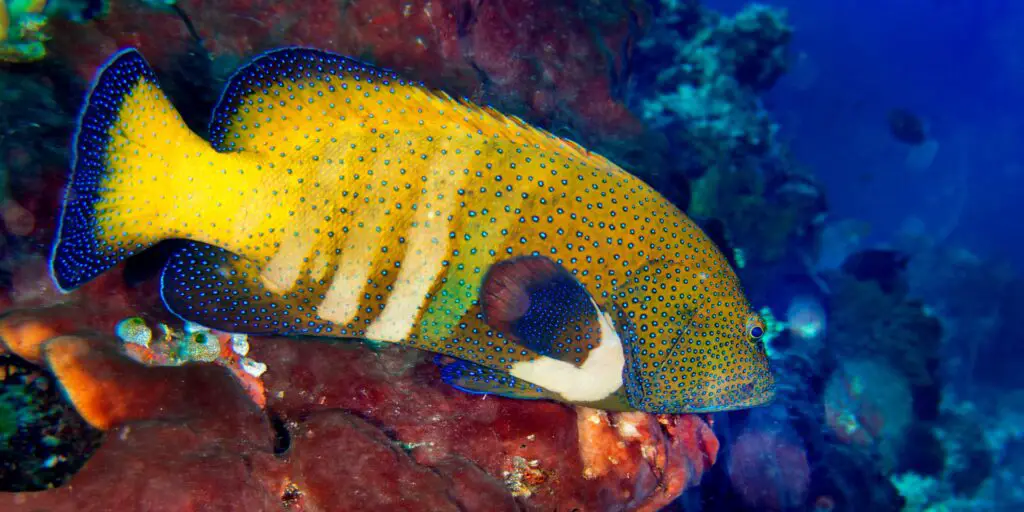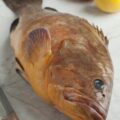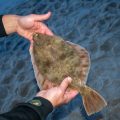The Peacock grouper, or Cephalopholis argus, is a type of grouper fish. It got its name from the Greek monster Argus because of its appearance. It is a fish mostly found in aquariums due to its beautiful appearance. This is one of the unique grouper species that looks good instead of the generic brown-gray body most common groupers have.
The peacock grouper’s body is colorful and unique, unlike other more common species of groupers. This is why they are frequently used as aquarium fish. They have a dark brown body like most groupers, but the body is covered in small blue spots that look like eyes from afar. A peacock grouper is also known as a peacock rock cod.
There is even more color on the body of the fish because the fins of peacock grouper also fade to a blue or purple color, making the ends stand out. When the fish gets larger in size, there are sometimes four to six lighter vertical bars on the back half of its body that are almost white in color.
The fish can actually change the color of its body. It can get lighter or darker depending on the mood, mating season, or if the fish simply wants to hide. The fish has a large mouth like most other predatory fish, with the lower jaw extending outward more than the upper jaw.

Size of peacock grouper
The fish gets smaller than the goliath grouper, one of the biggest grouper fishes. However, this fish is not tiny at all, either. The maximum size of the fish is 24 inches, but more commonly, they get around 10 inches to 15 inches. The lifespan of peacock catfish is actually unknown, but it is said that it can live for up to 40 years in the wild and much longer in captivity. However, this still needs to be confirmed. Even so, because the fish lives for a long time, it is also an invasive species in the water where it lives.
Habitat of peacock grouper
This is a species of grouper is considered to be an invasive species, and it is found in many different places around the world. The fish mainly thrives in warmer water. Peacock grouper can be found in the Red Sea from South Africa to French Polynesia and the Pitcairn Islands. Moreover, it is also found in northern Australia, Japan, and Lord Howe Island.
In the 1950s, it was also introduced to Hawaii, where it is again an invasive species, taking up the food of other rare fishes or making them their food, especially reefs. The fish was also responsible for ciguatera poisoning, making it inedible. You will be able to locate this fish mostly near coral reefs, where it can hide better, but the fish does not go below 130 feet in water.
Diet of peacock grouper
Most groupers’ diet is omnivorous, which is the same as peacock groupers. but the peacock grouper is more of a predator, so it relies on a more carnivorous diet more than an herbivorous diet. In their habitat, the fish prefer juvenile surgeon fish, lobsters, parrot fish, shrimp, and other crustaceans that are easy to catch. The mouth of this fish is designed to swallow the prey whole, and it follows different techniques to attack the prey.
The peacock grouper will usually hide during the morning and evening when they can camouflage better and attack the prey once they come closer. Sometimes the fish attack the prey in the middle of the water without hiding or ambushing it.
Interestingly, this fish is a very clever one, and it will follow other predatory animals like eels and octopuses to find food. In fact, sometimes, the peacock grouper makes a pact with the predator species, and they catch prey together. It is also reported that peacock groupers and other fish or species, will sometimes bully an eel into flushing prey for them. Therefore, female fish tend to swim together and catch prey together. On the whole, the peacock grouper is a very clever fish.
The behavior of peacock grouper
These are generally shy fish, but not in their habitat. Red sea male fish defend the harem of two to six fishes, and the female fish also protects the group from other female fishes. Each female fish defends a territory, which is how they collaborate.
The male peacock grouper approaches all the female fish daily by raising its dorsal fin, and the female fish does the same, and they meet to mate. Sometimes, the male fish will have a color fight when there is a territorial dispute. In this fight, both male fish will display their bright colors by switching their light-colored bars on the body from light to dark.
The winning fish is the one that is bigger and can change its color more. During this confrontation, the fish also makes threatening motions with its mouth. The losing fish will change its body color to be lighter to display defeat. If both fish are equally capable, it can result in a physical fight to find the winner of the territory.
Peacock grouper as a pet
As mentioned above, you can keep these peacock groupers in a tank, but their care is not easy. The fish requires a relatively large tank, and it is better kept in a group, especially when the fish is female. You can keep these fish in a community tank, but they will most likely eat most of the tankmates, so that is not a great idea either. People still like to keep this fish because of its appearance. In a tank, this fish draws attention with its beautiful body and markings. However, not everyone can keep them.
Conclusion
Peacock grouper is a species of grouper fish considered invasive because it lives for a long time and can reproduce almost anywhere. These are beautiful fish and are very clever. They can be kept in a tank, but it will take a large one and more than one peacock grouper. The peacock grouper is a predatory fish that lives near reefs in the wild natural habitat.










